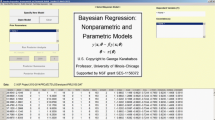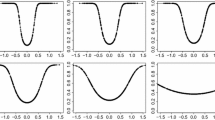Abstract
The cut function defined by the OpenBUGS software is described as a “valve” that prevents feedback in Bayesian graphical models. It is shown that the MCMC algorithm applied by OpenBUGS in the presence of a cut function does not converge to a well-defined limiting distribution. However, it may be improved by using tempered transitions. The cut algorithm is compared with multiple imputation as a gold standard in a simple example.




Similar content being viewed by others
Explore related subjects
Discover the latest articles, news and stories from top researchers in related subjects.References
Bennett, J., Wakefield, J.: Errors-in-variables in joint population pharmacokinetic/pharmacodynamic. Biometrics 57, 803–812 (2001)
Carrigan, G., Barnett, A., Dobson, A., Mishra, G.: Compensating for missing data from longitudinal studies using WinBUGS. J. Stat. Softw. 19(7), 1–17 (2007)
Carroll, R., Ruppert, D., Stefanski, L.: Measurement error in nonlinear models. Chapman and Hall, New York (2007)
Choi, J., Fuentes, M., Reich, B.J.: Spatial-temporal association between fine particulate matter and daily mortality. J. Comput. Gr. Stat. 53, 2989–3000 (2009)
Gelman, A., Meng, X.: Simulating normalizing constants: from importance sampling to bridge samplingn to path sampling. Stat. Sci. 13(2), 163–185 (1998)
Haining, R., Law, J., Maheswaran, R., Pearson, T., Brindley, P.: Bayesian modelling of environmental risk: example using a small area ecological study of coronary heart disease mortality in relation to modelled outdoor nitrogen. Stoch. Environ. Res. Risk Assess. 21, 501–509 (2007)
He, Y., Zaslavsky, A.: Combining information from cancer registry and medical records data to improve analyses of adjuvant cancer therapies. Biometrics 65, 946–52 (2009)
Heckerman, D., Chickering, D.M., Meek, C., Rounthwaite, R., Kadie, C.M.: Dependency networks for inference, collaborative filtering, and data visualization. J. Mach Learn. Res. 1, 49–75 (2000)
Jackson, C., Best, N., Richardson, S.: Hierarchical related regression for combining aggregate and individual data in studies of socio-economic disease risk factors. J. R. Stat. Soc. Ser A 171(1), 159–178 (2008)
Little, R.: Regression with missing x’s: a review. J. Am. Stat. Assoc. 87, 1227–1237 (1992)
Liu, F., Bayarri, M.J., Berger, J.O.: Modularization in Bayesian analysis, with emphasis on analysis of computer models. Bayesian Anal 4(1), 119–150 (2009)
Lunn, D., Best, N., Spiegelhalter, D., Graham, G., Neuenschwander, B.: Combining MCMC with ‘sequential’ PKPD modelling. J. Pharmacokinet Pharmacodyn. (January 2009). doi:10.1007/s10928-008-9109-1
Maucort-Boulch, D., Franceschi, S., Plummer, M.: International correlation between human papillomavirus prevalence and cervical cancer incidence. Cancer Epidemiol. Biomark. Prev. 17, 717–720 (2008)
Møller, J., Pettitt, A.N., Reeves, R., Berthelsen, K.K.: An efficient Markov chain Monte Carlo method for distributions with intractable normalising constants. Biometrika 93(2), 451–458 (2006)
Mwalili, S., Lesaffre, E., Declerck, D.: A Bayesian ordinal logistic regression model to correct for inter-observer measurement error in a geographical oral health study. J. R. Stat. Soc. Ser. C 54(1), 77–93 (2005)
Neal, R.: Sampling from multimodal distributions using tempered transitions. Stat. Comput. 4, 353–366 (1996)
Raghunathan, T.E., Lepkowski, J.M., Van Hoewyk, J., Solenberger, P.: A multivariate technique for multiply imputing missing values using a sequence of regression models. Survey Methodol. 27, 85–89 (2001)
Richardson, S., Gilks, W.: Conditional independence models for epidemiological studies with covariate measurement error. Stat. Med. 12, 1703–1722 (1993)
Rougier, J.: Comment on paper by Sansó, et al. Bayesian Anal. 3(1), 45–56 (2008)
Scollnick, D.: Bayesian reserving models inspired by chain ladder methods and implemented using WinBUGS. Actuar. Res. Clear. House 2014(2), (2004). http://www.soa.org/news-and-publications/publications/proceedings/arch/pub-arch-detail.aspx
Spiegelhalter, D.J., Thomas, A., Best, N., Lunn, D.: WinBUGS user manual, version 2.0 (2004)
Zhang, L., Beal, S., Sheiner, L.: Simultaneous vs. sequential analysis for population PK/PD data i: best-case performance. J. Pharmacokinet Pharmacodyn. 30, 387–404 (2003a)
Zhang, L., Beal, S., Sheiner, L.: Simultaneous vs. sequential analysis for population PK/PD data ii. J. Pharmacokinet Pharmacodyn. 30, 405–416 (2003b)
Acknowledgments
I started thinking about the cut problem after a presentation by Nicky Best at the IceBUGS meeting in 2006 (http://mathstat.helsinki.fi/openbugs/IceBUGS/Presentations/BestIceBUGS). Over the years, I have had many useful discussions with Nicky Best, Dave Lunn, David Spiegelhalter and Jon Wakefield. I would also like to thank Sylvia Richardson and Nicky Best for inviting me to give a talk on this topic at MCMSki IV.
Author information
Authors and Affiliations
Corresponding author
Electronic supplementary material
Below is the link to the electronic supplementary material.
Rights and permissions
About this article
Cite this article
Plummer, M. Cuts in Bayesian graphical models. Stat Comput 25, 37–43 (2015). https://doi.org/10.1007/s11222-014-9503-z
Received:
Accepted:
Published:
Issue Date:
DOI: https://doi.org/10.1007/s11222-014-9503-z




